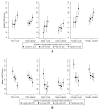Association of body composition with disability in rheumatoid arthritis: impact of appendicular fat and lean tissue mass
- PMID: 18821641
- PMCID: PMC2670990
- DOI: 10.1002/art.24109
Association of body composition with disability in rheumatoid arthritis: impact of appendicular fat and lean tissue mass
Abstract
Objective: To explore the association of measures of body composition with disability in patients with rheumatoid arthritis (RA).
Methods: Patients with RA underwent total body dual-energy x-ray absorptiometry for measurement of total and regional body fat and lean mass. The associations of measures of fat and lean mass with disability, measured with the Health Assessment Questionnaire (HAQ), were explored for the total cohort and by sex, controlling for pertinent demographic, lifestyle, and RA disease and treatment covariates.
Results: We studied 197 subjects (118 women, 79 men). Median (interquartile range) HAQ score was 0.625 (0.125-1.25) and was significantly higher, indicating worse physical function, in women than in men. HAQ score was strongly correlated with depression, pain, RA duration, duration of morning stiffness, Disease Activity Score in 28 joints, radiographic damage scores, levels of physical and sedentary activities, and body composition, with increasing fat and decreasing lean mass associated with higher HAQ scores. Appendicular fat and lean mass demonstrated the strongest association per kilogram with HAQ. Mean HAQ score was 0.52 units higher for subjects in the highest versus the lowest quartile of appendicular fat mass (P<0.001), and 0.81 units higher for subjects in the lowest versus the highest quartile of appendicular lean mass (P<0.001). Adjusting for demographic and RA characteristics partially attenuated these associations. The joint associations of appendicular fat and lean mass on HAQ were additive without significant interaction.
Conclusion: Body composition, particularly the amount of fat and lean mass located in the arms and legs, is strongly associated with disability in RA patients.
Figures


References
-
- Drossaers-Bakker KW, Zwinderman AH, Vliet Vlieland TP, van Zeben D, Vos K, Breedveld FC, et al. Long-term outcome in rheumatoid arthritis: a simple algorithm of baseline parameters can predict radiographic damage, disability, and disease course at 12-year followup. Arthritis Rheum. 2002;47:383–90. - PubMed
-
- Cohen JD, Dougados M, Goupille P, Cantagrel A, Meyer O, Sibilia J, et al. Health Assessment Questionnaire score is the best predictor of 5-year quality of life in early rheumatoid arthritis. J Rheumatol. 2006;33:1936–41. - PubMed
Publication types
MeSH terms
Grants and funding
LinkOut - more resources
Full Text Sources
Medical

